Text
Want to fanbind? Need davy boards/book boards and low on funds? I have an excellent hack for you:
Repurpose shitty books
"But!!!" You may say, "no book is shitty! All human experiences are worth putting to paper!"
You're right! But, also, Counterpoint:
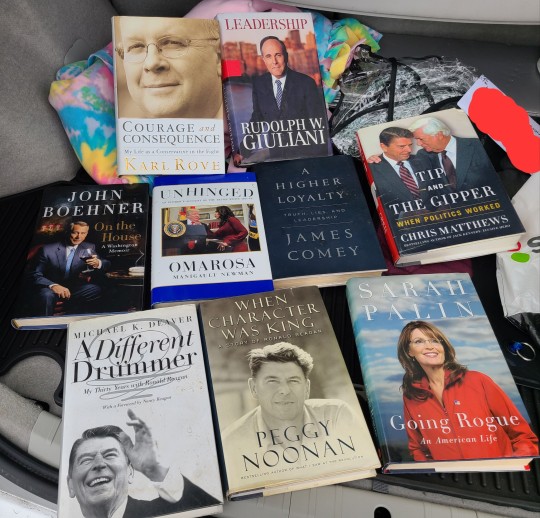
I went to my local thrift shop and got these for the low price of $5 for all 10. ("Getting into politics?" The lovely ladies behind the counter asked me. "In a manner of speaking," I replied.)
Once I got home, it was easy to turn them into this, their component parts:

("Please stop saying you're skinning them," my partner begged. Too late!)
[EDIT TO ADD: Here's a guide! Also on my tumblr. Also - when thrifting, bring a piece of paper folded or cut into the minimum size you need for boards: this way you can make sure you're getting big enough material!]
While these are just book boards, diligent deconstruction can even yield headbands, I'm pretty sure - I'll report back on my next trial run. [EDIT TO ADD: yup, you can!]
I cannot overstate the delight I have in giving these covers new life for binding fanfiction, particularly the queer kind.
Happy binding!
5K notes
·
View notes
Text



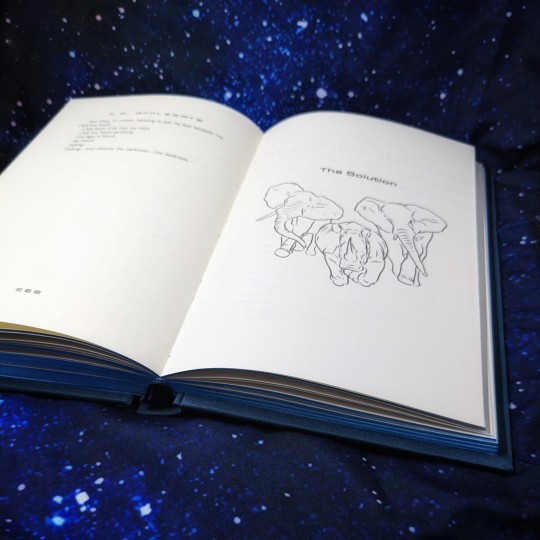
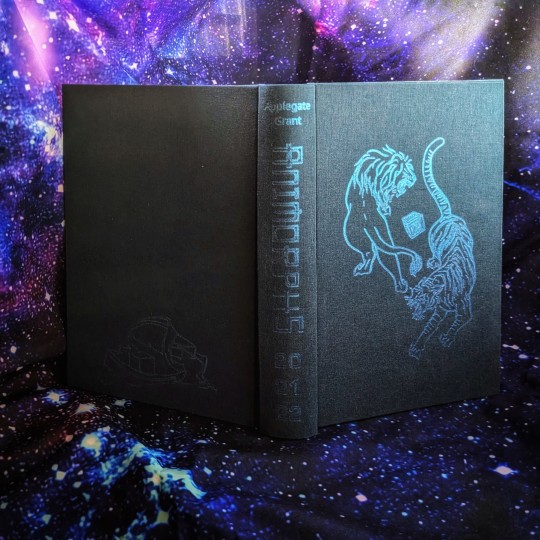
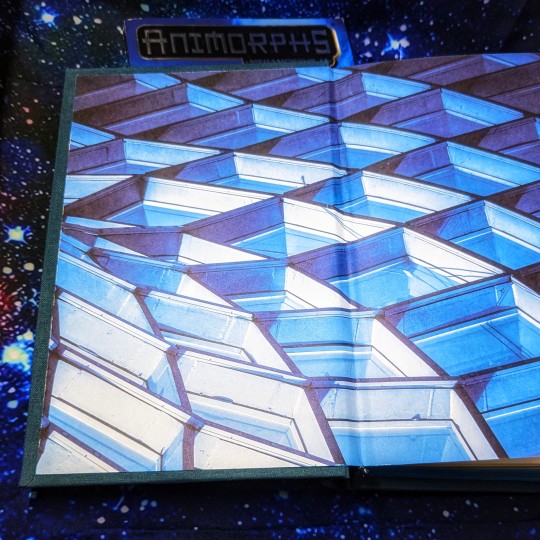
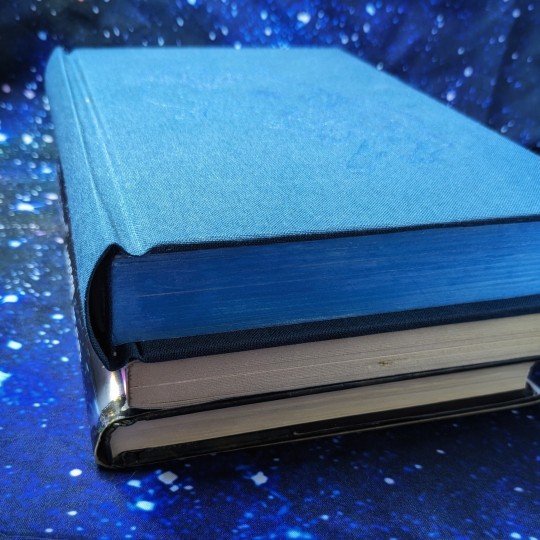
Animorphs #20-22 by @kaaauthor
This is a remake of a book I made almost exactly two years ago. That was the 11th book I ever made and this one is the 50th (!) I asked K.A. Applegate to sign the book while it was still in sheets, so I only had one chance to get it right.
🐅 Animorphs 20-22 was the first serialized arc in the 90s book series.
🐅 The heroes recruit a new kid to their guerilla team and grant him morphing powers, only for his selfish and sociopathic tendencies to jeopardize their fight against the alien invasion.
🐅 Young readers were challenged by this subversion of the "new kid" trope and the moral dilemma that developed. Do they kill a fellow teammate? How else can they neutralize him?
🐅 ALSO: Can these middle schoolers crash the G7 Summit and save Boris Yeltsin, Bill Clinton, and other heads of state from infestation?

Foil Quill on Verona bookcloth, with iridescent calligraphy ink edges. I wanted to give this trilogy the special edition it deserves.
153 notes
·
View notes
Text
Sorry, I am part of a guild, @renegadeguild, with a code of conduct that prohibits selling fanfic. That being said, I love helping people learn the craft, so if you want to make your very own, I'm down to help.


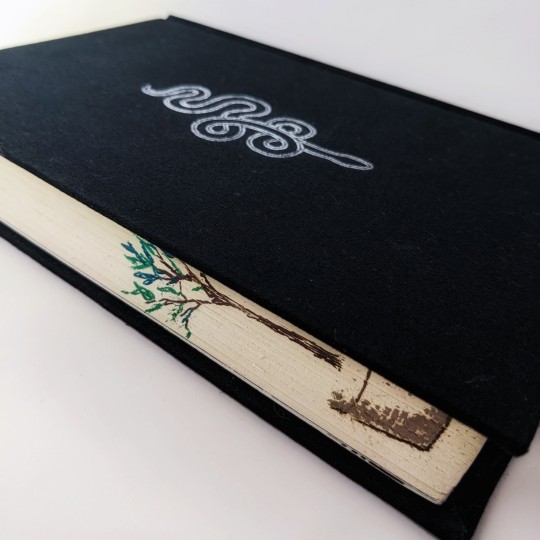



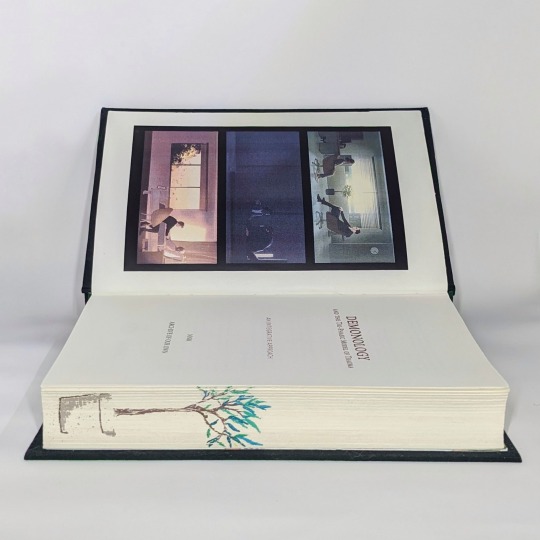
Demonology and the Tri-Phasic Model of Trauma: An Integrative Approach, a Good Omens fanfic by @mouseonamoose
After surviving the events of the apocalypse, Anthony J. Crowley goes to therapy. This fic is a well-researched and rich depiction of trauma therapy from the perspective of the mental health provider.
Bound in premium cotton from Worldcloth decorated with silver hot stamp foil and a hand painted foreedge. Frontispiece artwork generously provided by @rjrjrjrjrjrjrjrj. To enhance the reading experience, the typeset of this book was further annotated with additional commentary on the psychotherapeutic process (see footnote example.)
This book was bound and gifted to a fellow clinician in a different medical field as part of the @renegadeguild Mini Exchange, 2024.

400 notes
·
View notes
Text







Demonology and the Tri-Phasic Model of Trauma: An Integrative Approach, a Good Omens fanfic by @mouseonamoose
After surviving the events of the apocalypse, Anthony J. Crowley goes to therapy. This fic is a well-researched and rich depiction of trauma therapy from the perspective of the mental health provider.
Bound in premium cotton from Worldcloth decorated with silver hot stamp foil and a hand painted foreedge. Frontispiece artwork generously provided by @rjrjrjrjrjrjrjrj. To enhance the reading experience, the typeset of this book was further annotated with additional commentary on the psychotherapeutic process (see footnote example.)
This book was bound and gifted to a fellow clinician in a different medical field as part of the @renegadeguild Mini Exchange, 2024.

#good omens#demonology and the tri phasic model of trauma: an integrative approach#fanbinding#bookbinding#fanfic binding#ficbinding#good omens fanfiction
400 notes
·
View notes
Text
Violence in the Library by ArdentAspen2 on Ao3.
A Star Wars/Alien what-if crossover.
Still reeling from the revelation that Darth Vader is his biological father, Luke Skywalker takes leave. A casual visit to a library goes sideways when it is attacked by Xenomorphs! When Darth Vader arrives to investigate an alien presence like the one he encountered from his Jedi days, Luke and Vader team up to save the galaxy from the Alien threat.
I've been sitting on this bind for months waiting for the @renegadeguild California Mini Exchange to finish before posting! I will also be posting behind-the-scenes images and details on the paper engineering, but suffice to say this was one of my most ambitious books yet. The endpapers are a pop-up Facehugger and Chestbutster made from jute marbled paper. The cover was made from real scrap ostrich leather I bought from a shuttered bookbinding factory. It was very challenging to get it all to lie flat.
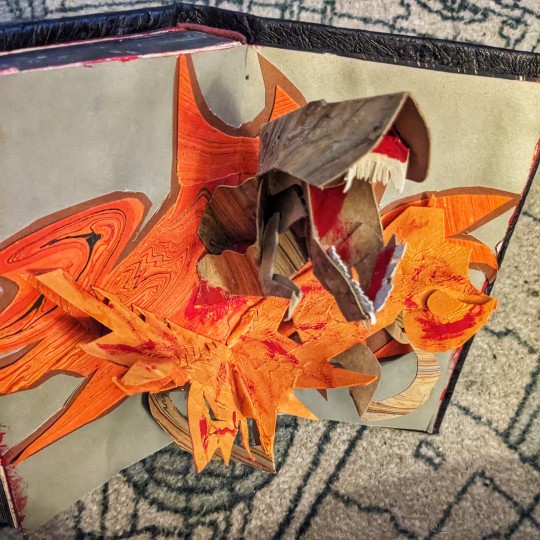
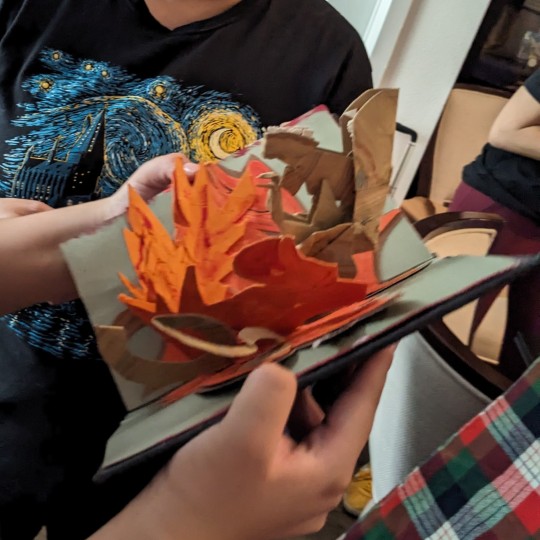
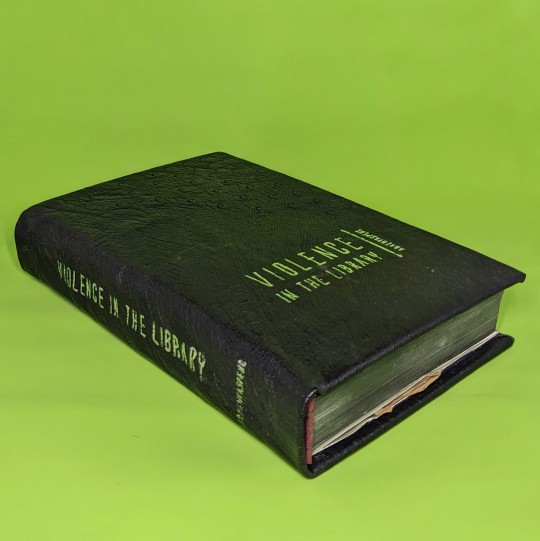
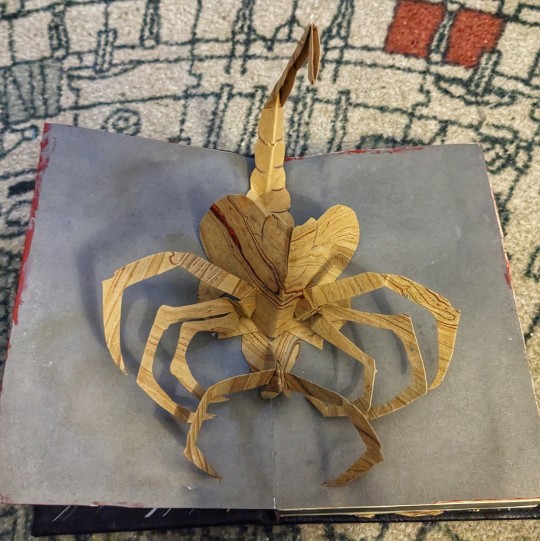
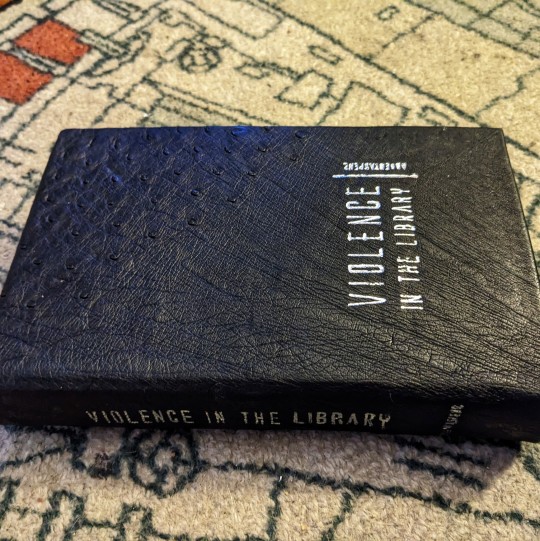


#bookbindersofinstagram #fanficbinding #fanbinding #starwarsfanfic #popupendpapers
53 notes
·
View notes
Text
Thank you, I will cherish this!
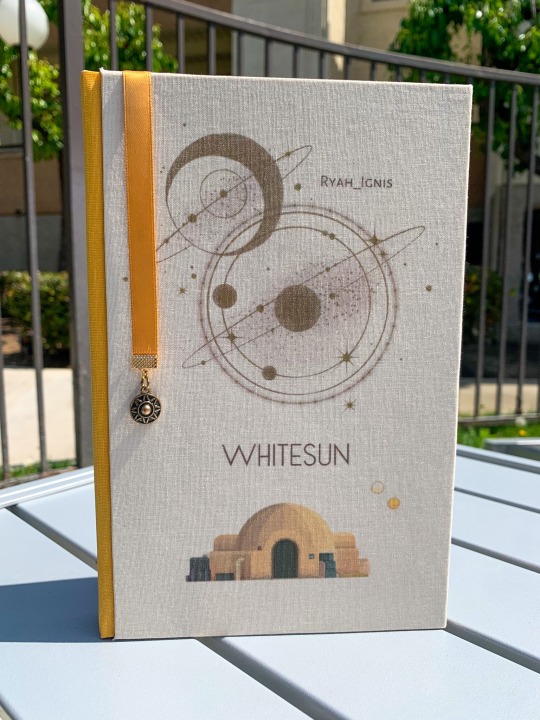
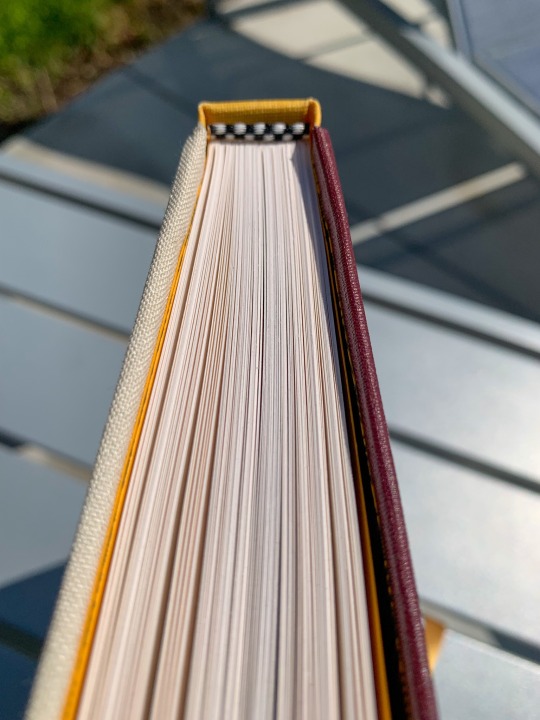


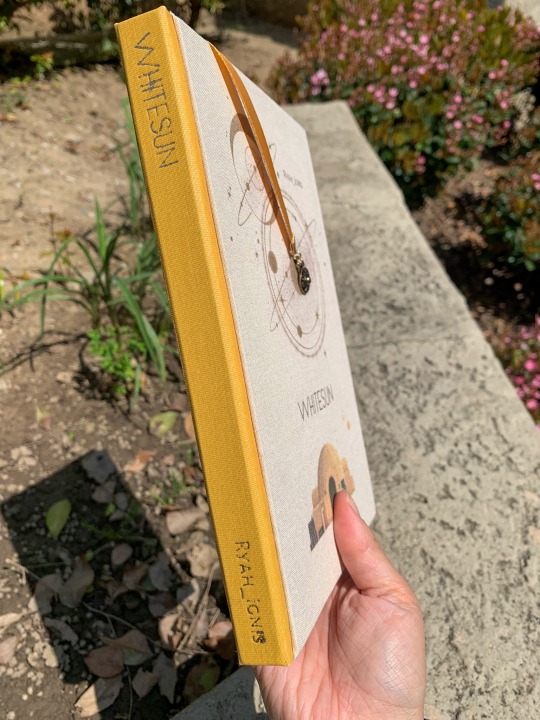
Whitesun by Ryah_Ignis
This is my second time binding Whitesun by Ryah_Ignis. I’m so glad I chose to remake it, because it came out so much cleaner this time, and the endpapers are much prettier.
This also means I have my own copy at home, which I get to reread. It’s a really cool story! Love Auntie Beru. And I now wish the original Star Wars trilogy played out exactly like this book, cuz who doesn’t wish Leia could have done some actual Jedi training with Luke? Just me?
This book was gifted to @starblightbindery for the @renegadeguild 2024 California Mini Exchange. It was a pleasure to read this story and also bind it. The cover is wooqu bookcloth, and it takes to inkjet printing really well.
Story can be found here on Ao3.
60 notes
·
View notes
Text
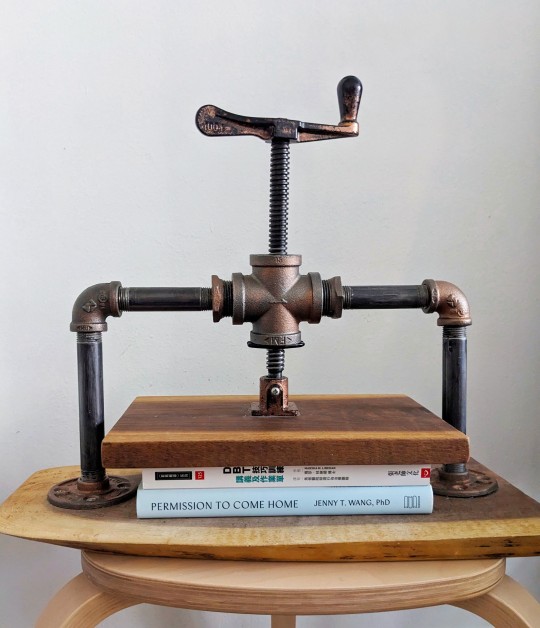
FanFic Pipe Book Press
In 2022, I prototyped an affordable nipping press using black steel pipe fittings. The challenge: To make something under $100, compact, portable, and easy to make without electric tools.
I'm sharing the supply list here (under the cut) with updated thoughts and notes.
Please note that when I've linked to Amazon in this post, I'm using an affiliate link.
Basic Materials
QTY
1 - Press Screw
2 - ½ pipe Mini Flanges
2 - ½ pipe 90° elbow fittings
2 - ½ pipe 4in nipples
2 - ½ pipe 6in nipples
2 - 1x½ pipe hex bushing reducer
1 - 1x1 pipe cross tee
1 - Large hardwood board at least 16"x6"
1 - Smaller hardwood board ~ 9-10" across and at least 6" wide
8 - #8x¾ flat head wood screws
Press Screw
The press screw is the crank/long screw in the middle of the nipping press. As of this writing, the most affordable press screws are the one by Pony Jorgenson or the one by ShopFox. For just a little bit more, McMaster Carr sells a beautiful stainless steel hole mount screw clamp from Taiwan.
½ pipe parts
These form the bones of this book press. Pipe fittings are designed to be resistant to water pressure and are easy to assemble. You can find some at your local hardware store (cheaper) or order on Amazon. You have the option to use basic black carbon steel pipe or go fancier by using stainless steel. This will likely run you between $40-$65.
Wood & Screws
You'll want a hardwood (like Oak, Birch, Walnut, etc.) not a softwood (pine or basswood) for this project to prevent warping. A strong plywood such as baltic birch may work as well. Most hardware stores will cut wood to size for you. The screws are for attaching the pipe to the wood--but, depending on how you want to engineer the press, you could also use bolts.
Additional Supplies
Sandpaper in various grades
Sealant for the pipes (especially if you use pipe that sheds carbon, so you don't stain your books. I used clear coat, you can look into shellac and other finishes that work for you.)
Wood Finish (I used tung oil, you have so many options)
Screwdriver, Hand Drill, or Electric drill
Mallet (if you want to pound the lead screw into the cross pipe
Epoxy to glue the lead screw into the cross, or to affix the base of the screw to the wood.
Optional Upgrades
Use a hole saw to drill through the wood and a forstner bit the size of the flange to run the flange through the wood from the bottom. That way, pressure isn't put on the wood screws and the press will last longer.
Use Rub N' Buff to decorate the press
Use longer nipples, such as 8" or 10" nipples, instead of the 6" to get more daylight.
This press is sized for fanfic binders, but if you want a bigger one you can size up the pipes.
If you can afford thicker wood, especially for the base, you may want to opt for 8/4 wood instead of 4/4 wood.
Happy crafting! Let me know how things go, and if you end up making one, I'd love to see a picture.
92 notes
·
View notes
Text



This is the bookbinding kit that I wish I had when I first started out.
The goal was to put all of the hard-to-source supplies in one newbie starter kit--only the good stuff that we fanbinders actually use. (Also, I really, really wanted a storage pouch celebrating our hobby.)
THE FANFIC BOOKBINDING STARTER PACK
So we've got:
Bone Folder
Awl
Hole Punching Guide
Bookbinding Needles
100% Linen Thread
Raw Beeswax
Linen or Ramie Tape
Mull
Pre-Made Endbands
Corner Miter
Resource Brochure
Fanfic Themed Pouch
Olfa Knife (optional, but so useful!)
I figure most people already have things like rulers and brushes at home, and other things like glue and boards are easier to source separately. I'm hoping this kit takes the stress out of finding all of the fiddly bits from people who are new to the hobby. (Seriously, why are Lineco products so expensive!!!)
I'm hoping to use this space to blog more about the kit as time goes by. It was several months in the making. Local fanfic binders in the SoCal area helped me figure out what to include and what to leave out. Their feedback on what to include in the resource brochure was invaluable.
I sourced materials from China, India, Poland, Lithuania, and even my local farmer's market. I taught myself 3D modeling to design the corner miter. I corresponded directly with linen and mull manufacturers. I learned a lot about bone folders.
Fanbinding is an act of resistance, liberation, and celebration. We're creating codices and preserving what we love. I don't bind in the fandom that inspired v.2.0's theme, but I know a lot of my fellow binders do. It was important for me to put the progress pride flag and trans pride flag on the kit to stick it to you-know-who.
#fanbinding#bookbinding#fanfic binding#renegade bindery#ficbinding#fan fiction#manacled#bookbinding kit
226 notes
·
View notes
Text
Earlier this week I reported on the very depressing for-profit fic pirating happening in certain corners of fandom—but (somewhat coincidentally, timing-wise) I also had the joy of reporting this story on fanbinding, and the work of the @renegadeguild! Featuring the words (and fanbinds) of the brilliant @celestial-sphere-press, @butterfingersbookbinding, and @fanboundbooks (who also talked about Renegade on the most recent Fansplaining episode).
Renegade's binders are strong proponents of the non-monetized gift economy—they truly embody the spirit of fanfiction, in my opinion, both in the communal way they share their work with fic writers and each other, and in the DIY way they approach making books:
There’s a strong parallel between the amateur, instinctive nature of fanfiction and the act of fanbinding. While plenty of fic is penned by formally trained writers, much of it is not. Tiffo, who binds as Fanboundbooks, likens the reverse-engineering involved in teaching oneself both activities. As writers, people try to figure out why stories work. Fanbinders collectively share the process of learning to turn that work into a physical object—tactile, clean, often beautiful. Fic is largely unencumbered by the forms and structures of traditional publishing, and fanbinders approach their work with the same spirit. “People will often say, ‘How do I do this?’ or ‘What’s the rule for this?’” Tiffo says. “The answer that we always try to throw in Renegade is, ‘This is what other people have done, but know that there is no rule to your book—you can make whatever you want.’”
It's a shame seeing people conflate the bad actors of the pirating situation—many of whom don't appear to be in fandom and seem motivated by pure profit—with the work of fanbinders at large, and seeing people scared to try out fanbinding because of the recent news. Not-for-profit fanbinding is just as legal as writing fanfiction, and I don't speak for all fic writers, but if someone ever bound one of my fics, I'd be so touched I would almost definitely weep. 😭
1K notes
·
View notes
Text
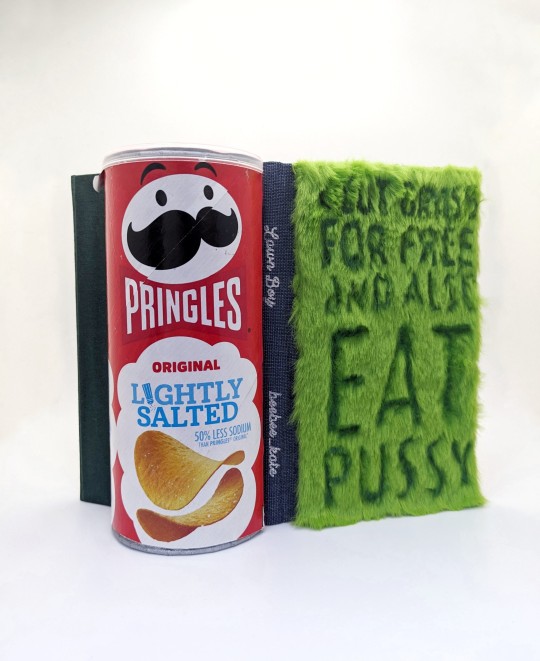


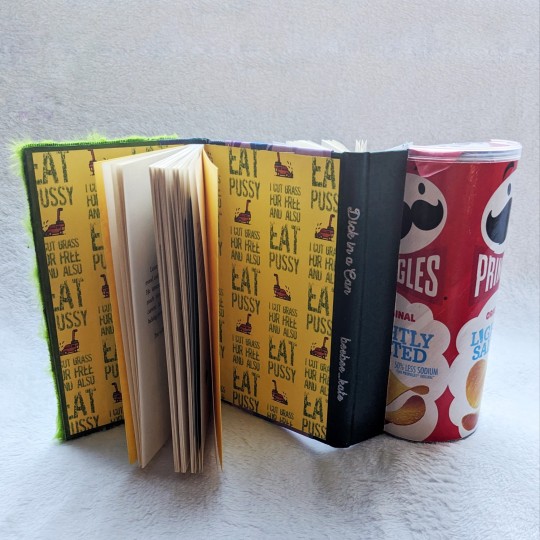


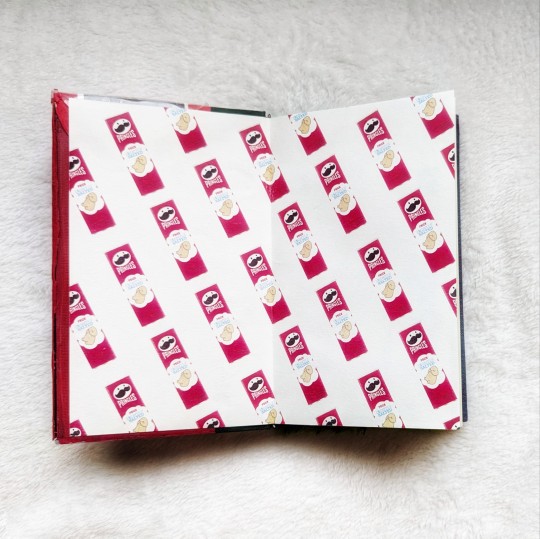
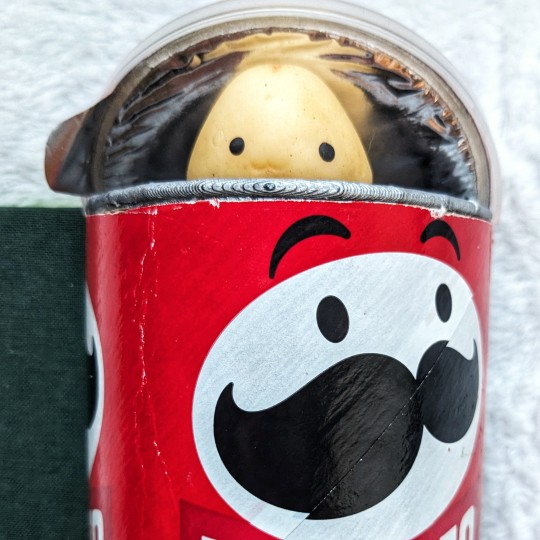

A dos-à-dos binding of Lawn Boy and Dick in a Can by beebee_kate. These are two Reylo modern AU textfics full of irreverent joy. Two legal quarto sized books sharing the same back cover.
This was my first ever dos-à-dos and I figured I might as well go as weird as possible with these two fics. This was also my first competition entry ever, to the reddit r/bookbinding contest!
49 notes
·
View notes
Text
Editor's Note from The Black Sands of Socorro by Patricia A. Jackson

While researching Patricia A. Jackson’s entire body of Star Wars work for a short story anthology, I came across the West End Games sourcebook Star Wars: The Black Sands of Socorro (1997.) It’s a crucial work of Star Wars ephemera: The first creator of color writing for Star Wars in an official capacity, writing not just about individual characters of color, but centering entire cultures populated by non-white characters. A young Black woman in the 1990s wrote science fiction for Star Wars, worldbuilding with concepts like antislavery, indigeneity, linguistic divergence, and settler colonialism...while Disney-Lucasfilm in the 2020s ineffectually positions Star Wars as a post-racial fantasy.
I non-hyperbolically refer to Patricia A. Jackson as the “Octavia Butler of Star Wars,” not because fans of color need to be officially sanctioned by Lucasfilm to create Star Wars content, but because of how difficult it is to carve out anti-racist space in a transmedia storytelling empire. Challenging even in transformational fandom spaces (e.g. fan works), to broach race in affirmational fandom spaces—or while writing content for the property holder—is to be unflinchingly subversive.
And Jackson did it first. In an interview with Rob Wolf in 2022, Jackson described her experience writing race into Star Wars in the 1990s as an “experiment.” The planet, peoples, and cultures of Socorro were a way for Jackson to obliquely, yet concretely, center Blackness and racial justice into Star Wars, pushing the racial allegory constrained by the original trilogy to its limits.
Since it’s inception, Star Wars has spent much of it’s storytelling on the fringes of the galaxy (whether it’s Tatooine or Jakku, Nevarro or Ajan Kloss.) The Black Sands of Socorro is an extension of that trope, but where the Star Wars films used indigeneity as set dressing (eg. “Sand People”, Ewoks, Gungans, etc.) Jackson creates a vivid world where indigenous culture and settler colonists collide; where characters are coded with dark skin and central to the action. The planet Socorro is distinct as a Star Wars setting. As one of the only places in the galaxy where slavery is eradicated with a vengeance, Socorro refuses to let go of a plot line Star Wars media often leaves behind. Socorro is a haven from Imperial fascism, a space where readers are invited to imagine a story that does not center around occupation.
When I learned that Patricia A. Jackson no longer has a physical copy of The Black Sands of Socorro, I realized that I had the materials and the means to create a fanbound hard copy for her home library (well, and also for my own home library.) While this handmade book is not an exact reproduction of the RPG supplement, I hope my renvisioning of the supplement as an in-universe travel guide lives up to the original work.
As the idea of creating a travel guidebook based on the original material percolated, I reflected on the State of Race in Star Wars in the year since I compiled Designs of Fate, an anthology of my favorite Patricia A. Jackson short stories. In May 2022, actress Moses Ingram debuted as Inquisitor Reva Sevander, the deuteragonist in the Dinsey+ streaming Obi-Wan Kenobi series. As predicted by Lucasfilm—and any fan sick of alt-right Star Wars related “whitelash”—Ingram was promptly subjected to a firehose of racialized harassment and misogynoir.
Yep, fascist self-proclaimed fanboys complained about a Black woman Inquisitor in 2022, having no idea (or deliberately whitewashing) that one of creators of the entire freakin’ concept of Inquisitors was a Black woman writing for the Star Wars Adventure Journal three decades ago.
Then, a public facing Star Wars account (@StarWars on Twitter) broke precedent and slapped back at the trolls. Lead actor Ewan McGregor filmed a video retort, posted on @StarWars, stating “racism has no place in this world” and telling off the racist bullies: “you’re no Star Wars fan in my mind.” A few months later, Disney+ debuted it’s second flagship Star Wars streaming series of the year, starring a Latino actor as the protagonist. In the opening episode of Andor, a police chief describes Diego Luna’s eponymous lead as a “dark-featured human,” perhaps the closest the franchise has ever gotten to acknowledging out-of-universe constructions of race, to date. The series explored aspects of imperialism with more depth than Star Wars had previously done on screen, such as the Empire’s treatment of the native people of Aldhani. And, in November, the The Acolyte, a Disney+ series co-developed by Rayne Roberts, announced Amandla Stenberg and Korean actor Lee Jung-jae as its top-billed leads. Stenberg will be the first Gen Z, mixed race, Black, Inuit, queer, and non-binary actor to lead a major Star Wars series.
On the Patricia A. Jackson Star Wars front, in 2022, Jackson’s character Fable Astin was an easter egg in the Obi-Wan Kenobi series. Jackson will again write for Star Wars in an official capacity in From a Certain Point of View: Return of the Jedi, due for publication in Fall 2023. A series about Lando Calrissian, the galaxy’s most famous Socorran, is still in production, so I have my fingers crossed that we may soon see Socorro on camera.
I wonder if this past year will have been a fulcrum year for BIPOC fandom. Maybe Disney has finally realized it’s bad for business that the alt-right uses social media algorithms and Star Wars fan spaces as a soft recruiting ground to radicalize young white men? Maybe Star Wars as a franchise will continue to loudly disavow fan whitelash and firmly position performers of color in true leading roles? I really hope so. On the other hand, as much as I am in favor of increased representation in Star Wars storytelling, I am also troubled by Disney-Lucasfilm’s framing of the Galaxy Far, Far Away (GFFA) as “colorblind.” Recently, Star Wars fans have been asked to accept that in the (a long time ago) sci-fi futurepast GFFA, humans have always been post-racial, and it’s just a coincidence that racialized people were not caught on camera the way white characters have been for years. The galaxy is post-racial and it’s just acoincidence that the movers and shakers of the galaxy have largely been depicted as white men for the past 40 years of media.
For example, in the decade since Disney rebooted the expanded universe, fans have learned that Star Wars’s biggest galactic war criminal to never be depicted on screen is Admiral Rae Sloane, a bisexual Black woman who was the leader of Imperial remnant forces, one of the architects of the First Order, and personal mentor to General Hux. Under Disney-Lucasfilm’s post-racial retcon of the Star Wars universe, the allegorical fascists are intersectional equal opportunity employers (at least in expanded universe content like animation, video games, and novels.) Along those lines, several of the franchise’s newly introduced, prominent women of color have been part of the Empire: Imperial loyalist Cienna Ree (Lost Stars), Inferno Squad leader Iden Versio (Star Wars: Battlefront II) former stormtrooper Jannah (Episode IX), First Order pilot Tamara Ryvora (Star Wars: Resistance), Inquisitor Trilla Sundari (Jedi: Fallen Order), Captain Terisa Kerrill (Star Wars: Squadron) and, most recently, Inquisitor Reva Sevander. Once the sole purview of stodgy, very white and very British men (demonstrably so even in the sequel trilogy movies,) now anyone can be a stooge of the Empire.
That’s not to say that marginalized people can’t collude with fascism, or that there haven’t been heroic characters of color introduced in recent years. Rather, I posit that in order to sell audiences on the post-racial/colorblind GFFA, fascist-of-color characters like Rae Sloane or Giancarlo Esposito’s Moff Gideon (The Mandalorian) are created by necessity. The franchise wants to at once be racially inclusive and yet never directly address race. In Star Wars, real world oppression is primarily explored through allegory—such as Solo (2018)’s bit on droid rights, the clone army, or the myriad of non-human alien bodies that nonetheless are coded with racial stereotypes. A lot has been said about how allegory in sci-fi allows audiences to grapple with inequality from a comfortable distance, and not enough has been said about which audience is being prioritized for comfort.
What does it mean when race is supposedly a non-issue for humans in the GFFA, but creators and actors with marginalized identities cannot participate in Star Wars in any capacity without experiencing identity-targeted harassment? In the past ten years, this has been true even for white women like Kathleen Kennedy and Daisy Ridley, but the vitriol has been most strongly directed towards Black women like Lucasfilm Story Group lead Kiri Hart, author Justina Ireland and The High Republic Show host Krystina Arielle. Can the Galaxy Far, Far Away truly be “colorblind” or “post-racial” (never-racial?) if the narrative continually centers white characters and replicates all the common racial inequities seen in commercialized Hollywood storytelling? Upon the release of The Force Awakens in 2015, critic Andre Seewood aptly described Finn’s positioning in the story as “hyper-tokenism,” even presciently predicting that Finn would continue to be hyper-tokenized in Episodes VIII and IX. As the narrative veered away from Finn, it also left unrealized a stormtrooper rebellion plot line where Finn could have been, in effect, a Black abolitionist. Actor John Boyega’s critique of his experience in the sequel trilogy aligns with Seewald’s assessment: “Do not bring out a Black character, market them to be much more important to the franchise than they are and then have them pushed to the side.”
Published in 1997, The Black Sands of Socorro came before Finn, before Mace Windu, back when all the melanin of Star Wars could be found in Billy Dee Williams’s singular swagger and James Earl Jones’s distinctive voice. Back then, the most prominent Black actress in the original trilogy was dancer Femi Taylor, who played Oola, the hypersexualized green twi’lek fed to the rancor in Return of the Jedi. Bantam Spectra, the publisher that held the license for Star Wars from 1991 to 1999, had no leading characters of color in its’ Expanded Universe. The first full length Star Wars novel by a writer of color, Steven Barnes’s The Cestus Deception15, would not be published until 2004. Even though the book featured two protagonists of color, they would not be depicted on the cover. At Comic-Con in 2010, I spoke with Tom Taylor, a white Australian comic book writer who tried to make the lead family in Star Wars: Invasion (2009) a Black one, but was shut down during the creative process. The comic instead depicts a family of blondes, because the publishers did not think fans would embrace leads of color. All this to say, the inclusion of melanated characters in Star Wars has been so, so hard fought. It’s incredible The Black Sands of Socorro exists at all. It’s more than worthy of celebration, and I’m floored that more attention has not been brought to it.
Patricia A. Jackson is a smuggler.
This sourcebook was explicitly written to assist fans in telling their own Star Wars stories, and in it Patricia A. Jackson smuggled in emphatic allusions to the Black Panther movement and the trans-Atlantic slave trade, smuggled in commentary on indigeneity and settler colonialism, and smuggled in multiple ways for fans to envision characters of color. Her writing has consistently added richness to the GFFA, and in The Black Sands of Socorro she envisions multiple histories for multiple cultures coded as non-white. She ensured the existence of not mere tokens, but flourishing societies of people of color in Star Wars.
The coda for The Last Jedi again shows how perilously close to tokenization characters of color, particularly Black characters, are in modern day Star Wars. In this film, the franchise returns to itsprevious exploration of slavery with the depiction of enslaved children on Canto Bight. The last speaking lines of the film are from Oniho Zaya (played by Josiah Oniha, a young Black British actor) who recounts Luke Skywalker’s heroic exploits to the other children. The film then closes out by showing that one of the downtrodden children is Force-sensitive—a future hero in the Star Wars mythos. In a film where every single Force-user depicted is white, the next generation kid with the potential is, again, a young white boy. Once again, the Black character can only serve the narrative in a supporting role. A franchise depicting a colorblind fantasy continually reifies racial and gender hierarchies in America. With The Acolyte, scheduled for release in 2024, it’s possible the franchise may finally be shifting past hyper-tokenism. In the meantime, fans of color and our erstwhile allies will continue doodling in the margins.
In the end, the sequel trilogy left the Canto Bight plot line (and the overarching slavery plot line started in Episode I) unresolved. I’d like to think the Black Bha’lir strafed Canto Bight and grabbed those kids. It seems like something they would do. Out among the stars, Oniho Zaya is adventuring with Drake Paulsen, and his story does not bracket another characters’; he is central. The Black Sands of Socorro is a launching pad for stories like that. It represents how fans of color have always carved out pieces of Star Wars for ourselves.
#socorro#star wars legends#swrepmatters#star wars adventure journal#star wars d6#patricia a. jackson#fanbinding#binders note
29 notes
·
View notes
Text

Editor's Note from my bind, Designs of Fate, an anthology of Star Wars stories by Patricia A. Jackson.
Patricia A. Jackson is a criminally underrated Star Wars author.
I’ll explain.
Growing up in the late 1990s and early 2000s, it was challenging to be an adolescent Star Wars fangirl, particularly an Asian American one. Back then, fandom meant negotiating male-dominated online message boards where identifying as a teenage girl meant inviting a ‘fake geek girl’ grilling at best and sexual harassment at worst. Most of the published Star Wars books were about Han, Leia, and Luke. Han and Leia were in their thirties and the parents of three children...not super relatable for preteen me. As far as character development was concerned, our “Big Three” had established characterizations coalesced firmly on the side of good. For our heroes, there was no moral ambiguity as, novel by novel, they tackled the galactic Threat of the Week.
Bildungsromans, those books were not. When Jackson started writing Star Wars in the 1990s, there were no women Jedi or protagonists of color. If you wanted stories with original characters coming of age, your primary recourse was the West End Games’ Star Wars Adventure Journals and their published anthologies, Tales from the Empire (1997) and Tales from the New Republic (1999). I remember avidly poring over my dogeared paperback copies and stalking the internet for scans or transcriptions. Although I never played the D6 role-playing game, the short stories from the Star Wars Adventure Journals helped me envision that a character like me—a young Asian girl coming into her own—did have a place in Star Wars after all.
As evinced by the vitriolic reactions towards John Boyega and Kelly Marie Tran during the production of the sequel trilogy, Star Wars fandom can be a hateful environment for proponents of diversity and inclusion. A small but irritatingly loud faction of fascist-leaning, cishet, white male fans are actively hostile towards fans who advocate for change; they are more troubled by the presence of queers, women and BIPOC than our absence. Because of the ubiquity and popularity of Star Wars in America’s cultural milieu, the sentiments from these self-appointed gatekeepers have been—and continue to be—amplified by right wing extremists, and, to some extent, even by the Internet Research Agency as tools of Russia’s psychological and cyber warfare against the United States. During his Ph.D. candidacy with the Department of Information Studies at UCLA, Morten Bay, PhD., studied negative tweets about The Last Jedi and found that 50.9% of negative tweets were “bots, trolls/sock puppets or political activists using the debate to propagate political messages supporting extreme right-wing causes and the discrimination of gender, race or sexuality.”
“Russian trolls weaponize Star Wars criticism as an instrument of information warfare with the purpose of pushing for political change,” he wrote, “while it is weaponized by right-wing fans to forward a conservative agenda and for some it is a pushback against what they perceive as a feminist/social justice onslaught.”
The creation and inclusion of characters with minoritized identities in Star Wars is, therefore, an act of resistance. As far as I’m aware, Patricia A. Jackson was the first woman of color and Black author to write for the Star Wars expanded universe. Jackson has described the fan environment in the 1990s thusly; like many minoritized fans of color, she would be given pithy justifications such as "Well, there’s no Africa in Star Wars, so there are no Black people." Jackson noted, aptly, "That was just translation for “’You don’t matter. You don’t need to be here.’” Jackson's work for West End Games, particularly her sourcebook The Black Sands of Socorro, is a subversion of those expectations.
Before anyone else did, Jackson showed fandom that dominant mayo masculinity did not have to be the only way to tell Star Wars stories. Her stories existed before the prequel trilogy and three decades of Star Wars publishing, before FanFiction.net, Archive of Our Own, or Wattpad. She is the forerunner for BIPOC writers in Star Wars, followed by other luminaries like Steven Barnes, Daniel José Older, Nnedi Okorafor, Rebecca Roanhorse, Ken Liu, Greg Pak, Alyssa Wong, Sarah Kuhn, Saladin Ahmed, C.B. Lee, Justina Ireland, Alex Segura, Zoraida Cordova, Greg VanEekhout, Mike Chen, Charles Yu, R.F. Kuang, Sarwat Chadda, Sabaa Tahir, and Renée Ahdieh.
Jackson had and continues to have an incredibly prescient understanding of what makes a good Star Wars story. Any of the stories in this anthology could find a home as an anime short from Star Wars: Visions (2021). Ideas from Jackson’s Star Wars short stories have appeared in later media, sometimes decades later. Whether convergently evolved or directly influenced, the parallels are astonishing: Kierra, the snarky feminine droid consciousness who inhabits Thaddeus Ross’s ship, is a spiritual predecessor to L3-37, Lando Calrissian’s snarky feminine droid companion from Solo (2018) who ends the film uploaded to the Millennium Falcon. Jackson addressed concepts like slavery and Force healing predating the prequel and sequel trilogies. In “Idol Intentions,” she created an adventuring academic on the hunt for artifacts long before Kieron Gillen brought Doctor Aphra to life. Squint and the upturned red salt on the planet Crait in The Last Jedi becomes flying red soil on the planet Redcap. Dark haired, dark side tragic emo boy starcrossed with a fiery girl Jedi?—I think Jackson understood intuitively the appeal of this trope to a woman-dominated contingent of fandom well before “Reylo” topped Tumblr’s fan favorite relationship charts in 2020.
Jackson’s work is also significant for deepening world building. Much like how Timothy Zahn introduced analysis of fine art to Star Wars with his villainous art connoisseur Grand Admiral Thrawn, Jackson’s stories introduced concepts such as the evolution of Old Corellian, the acting profession, and Legitimate Theatre. These elements added verisimilitude to the expanded universe; it makes sense that different cultures in Star Wars would have archaic languages, folk songs, and old stories of their own from even longer ago in galaxies far, far, away. More recently, the franchise has started to flesh out in-universe lore in Star Wars: Myths and Fables (2019) by George Mann. Still, Uhl Eharl Khoehng in “Uhl Eharl Khoehng” (1995) remains the finest example of mise en abyme in any Star Wars related work.
Themes from Jackson’s Star Wars works, particularly around Drake Paulsen and Socorro, also connect contemporaneously with our real world. When the Seldom Different is essentially ‘pulled over’ by Imperial authorities in “Out of the Cradle” (1994), stormtroopers lie about Drake Paulsen having a weapon as a pretense to terrorize the teenager. It’s a collision of space opera with Black youths’ past and current experiences of police brutality and state-sanctioned violence. Accordingly, this capricious encounter is the rite of passage that jars Drake out of his childhood. I cheered when I read The Black Sands of Socorro (1997) and saw that the Black Bha'lir smuggler’s guild is named for a bha'lir, depicted in the book as a large...panther. Few Star Wars expanded universe authors—particularly in the 1990s—leveraged their influence to center characters of color or to allude to racial justice movements. Jackson did both.
For this anthology, I have copy edited and also taken the liberty of, when applicable, substituting some gendered or sanist language with more contemporaneous wording.17 The stories are otherwise intact. It would be remiss of me if I did not note; however, that one of the stories, “Bitter Winter” (1995), has sanist and ableist tropes that could not be contemporized without making dramatic changes to the story. In this story, the fictional disease brekken vinthern drives those impacted to violence; while it’s real world correlate of major neurocognitive disorder can include symptoms of aggression and agitation, extreme violence is rare and people with this condition are also at great risk of being harmed by violence. The tropes “Mercy Kill” and “Shoot the Dog” are depictions of non-voluntary active euthanasia, typically from the perspective of the horrified “killer” placed in an impossible situation. These tropes frame murder and death as “putting someone out of their misery” while downplaying any alternatives (ie: sedation to alleviate suffering, medical attention, or, say, ion cannons to render a ship inoperable without killing.)
Like in our society, the societies in Star Wars have consistently framed mental illness pejoratively. There are certainly valid critiques of the utter inadequacy of health care in Star Wars. Ableism is ubiquitous in entertainment media, and even with it’s problematic tropes, “Bitter Winter” remains one of the more humanizing depictions of a mental health condition in Star Wars fiction. I have included it in this anthology as a rare example of moral ambiguity in the franchise.
With the exception of “Fragile Threads” and “Emanations of Darkness,” the stories here are presented not in published order, but in chronological order as they would have occurred in the Star Wars universe. Ordering the stories chronologically helped clarify timelines; it also allows the anthology to begin with “The Final Exit,” which was a fan favorite back when it was first published. I’ve interwoven the Brandl family stories with Drake Paulsen’s coming of age adventures, as the Paulsens are such a strong foil to the Brandl family.
Since “I am your father” dropped in 1980, Star Wars has been big on Daddy Issues—intergenerational trauma, parental relationships, broken attachments, identity development, and initiation into adulthood (or, as Obi-Wan Kenobi would put it, “taking your first steps into a larger world.”) With Drake, we see that Kaine Paulsen is a father who is gone but ever-present. With Jaalib, we see that Adalric Brandl is a father who is ever-present but clearly far gone. Drake knows his Socorran roots; he has community and found family. Fable’s identity is adrift; she was torn from her roots after her fugitive Jedi mother’s death. Jaalib’s roots are scaffolded by disingenuous artifice. There is a diametric interplay of identity formation and parental legacy in these short stories that captures classic themes from Star Wars. And, the stories challenge readers to consider how we interact with shame, guilt, and obligation. Through the morally ambiguous dilemmas that are her oeuvre, Jackson’s characters discover who they are and where they stand.
While the thrill of having an Imperial Star Destroyer drop out of hyperspace is pure Star Wars energy, Jackson’s stories also disrupted what fans had come to expect. Published online as fan fiction, “Emanations of Darkness” (2001) polarized fans of the previous Brandl stories, particularly with Fable’s decision to throw her lot in with Jaalib and his father. At the time, Star Wars fan commentator Charles Phipps noted how the story dealt with the insidiousness of the dark side by taking potential heroes and crushing them. “Star Wars, I've never known to leave a bitter taste in my mouth,” he wrote, stunned. “I don't like what it's brought out in my feelings or myself...Bravo Brandl, you have your applause.” Although the Brandl stories were written and published before Revenge of the Sith (2005), Fable and Jaalib’s relationship mirrors the relationship between Padmé Amidala and Anakin Skywalker, down to both Jaalib and Anakin selling their souls to the same Emperor in hopes that will spare the women they love.
The prequel trilogy introduces the Jedi Council’s detached approach to attachments—don’t feel it, emotions like fear or anger are to be shunned, else suffering will follow. Anakin Skywalker’s broken attachments to his mother and Padmé lead him to turn against his values; his inability to integrate or tolerate his attachments is his downfall. It’s the same in the Brandl stories where, trauma bonded, Fable and Jaalib cannot let each other go. While Jaalib credits this as how he was able to preserve a bit of himself while under the Emperor’s thrall, his inability to extricate himself from his father’s influence or to let go of Fable ends up dooming her.
This is why I was thrilled to discover “Fragile Threads” (2021) on Wattpad twenty years later. In this story, Drake Paulsen helps his lover Tiaja Moorn save her sister, at the cost of losing their relationship when she decides to remain on her homeworld. Drake doesn’t fight her decision, he accepts it. He can hold onto that connection to Tiaja, just as he knows he will always be connected to Socorro, his father, and the Black Bha'lir. Drake can love freely because he knows what Luke Skywalker told Leia in The Last Jedi: “No one is ever truly gone.” He is able to straddle the fulcrum of attachment and love without letting it consume him, and that is balancing the Force.
Contemporary fandom discourse is also a struggle with attachment; the parasocial relationships we form with characters and stories are similar in process to how we attach to the important people in our lives. We imbue with meaning and carry these stories with us. As Star Wars storytelling enters its fifth decade, the divide between affirmational fandom (allegiance to manufactured nostalgia) and transformational fandom (allegiance to iterative and transgressive fan engagement) has factionized fandom. When Star Wars is seen as a totemic object, right wing fans have agitated for a return to a mythic past where white men were centered and morality was Manichean. From where I stand, at the heart of this debate is whether or not the reader or Star Wars is permitted to “grow up”—to leave the cradle, to evolve new identities and explore shades of grey.
To me, Jackson’s stories are a reminder that characters of color and complex moral dilemmas have always been a part of Star Wars. We have always been here. No other Star Wars author has been as exquisitely aware of the significance of storytelling; how it can help people challenge existing beliefs and discover themselves. Since the beginnings of the expanded universe, Patricia A. Jackson has spun yarn, and those fragile threads have tethered readers like myself to a galaxy far, far away.
Ol'val, min dul'skal, ahn guld domina, mahn uhl Fharth bey ihn valle. (Until we next meet, may the Force be with you.)
#star wars legends#patricia a jackson#star wars adventure journal#swrepmatters#binders note#patricia a. jackson#fanbinding
6 notes
·
View notes
Text




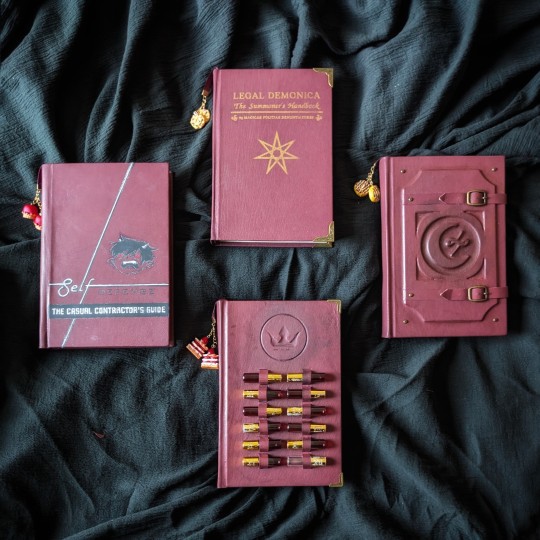


The full set of leather bindings for The Guild Codex: Demonized by Annette Marie. The designs were inspired by descriptions in the text and art by @ashoakmaple in the Webtoon adaptation. Each cover is based on an in-universe book in the story, with the title of the novel foil quilled on the spine.
I really love this series and recommend it to anyone who enjoys urban fantasy, banter, character development, slow burn, and baked goods.
22 notes
·
View notes
Text


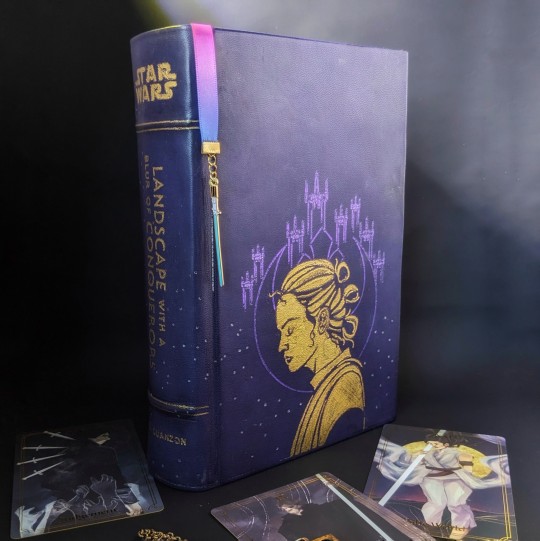

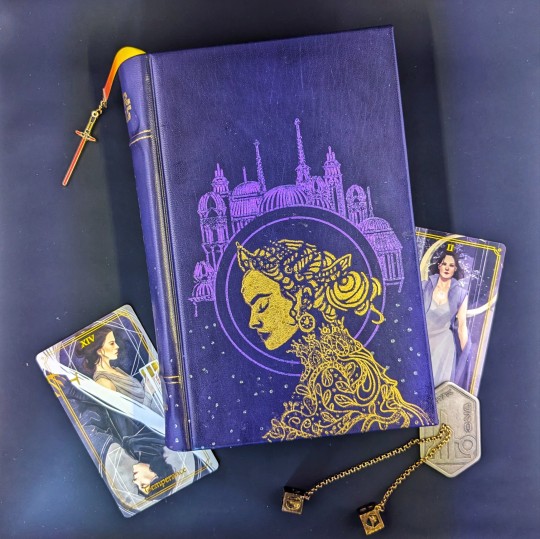

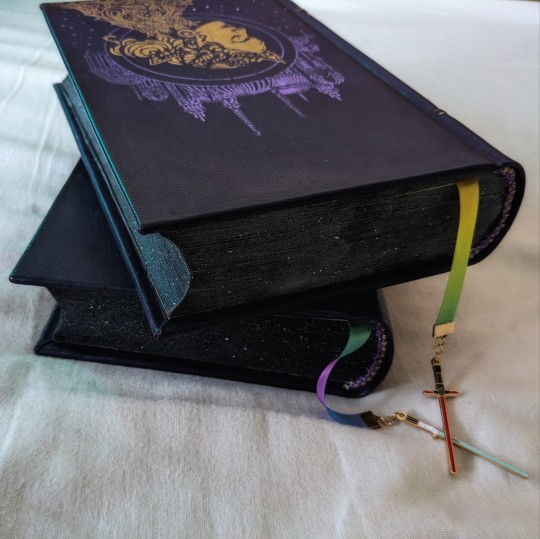



Forty books later, I've made another set of this fanfic by @theaguanzon, which does the best job of capturing how it felt to be 13 and reading Star Wars books in the 2000s. This set is a collaboration between myself and @selunchen, who did an amazing job illustrating the covers!
(The covers are inspired by an iconic Star Wars teaser poster. Do you know which one?)
This bind incorporates all the new techniques I've picked up over 2.5 years in this hobby. I foiled the line art on veg tan goat leather from Siegel, and there are Crepaldi endpapers and bookmark charms from @afterblossom.
The maps are based on Legends maps designed by Dan Wallace, Jason Fry, Chris Barbieri, and James Luceno. I revamped the typeset and painted the edges with a galaxy splatter pattern, and this bind is also rounded and backed.
#fanbinding#fanficbinding#lwaboc#reylo#diasterisms#reylofanfic#renegadepub#bookbinding#leatherboundbook#boundfanfic#starwarsfanfic
271 notes
·
View notes
Text



SoCal Renegade Bindery
📚10/22/2023📚
At today’s SoCal @renegadepublishing meet up, I shared my Little Prince rebind with many other incredibly skilled binders who in turned shared their gorgeous handmade books. We all got lunch together before going to the International Printers Fair in Carson.
#bookbinding #thelittleprince #bookbinder #bookstagram #classicbooks #rebinding #antoinedesaintexupery #papercrafts #bookart #renegadebookbinding #renegadepub #renegadepublishing
53 notes
·
View notes
Text
These are my kits! I love them.
Bookbinding Starter Kits!

A little PSA for my friend and fellow Renegade member Starblight Bindery: if you're looking to start bookbinding but are also deeply confused about where to source equipment, or want something more affordable but of decent quality, Starblight has made a starter pack of the harder-to-find materials! And these are legit high quality materials (linen tape or ramie band!!), plus some custom 3D-printed tools, PLUS the cutest bag. I have all these materials myself but am considering getting it just to get the bag. :D
While it doesn't have literally everything you need to bind a book, she included a list of where to source other tools and materials if you don't have them already.
Shipping is free in the US, and she can also ship to Canada and Australia. If you're from another country, let me know and I can pass that on to her.
522 notes
·
View notes
Text




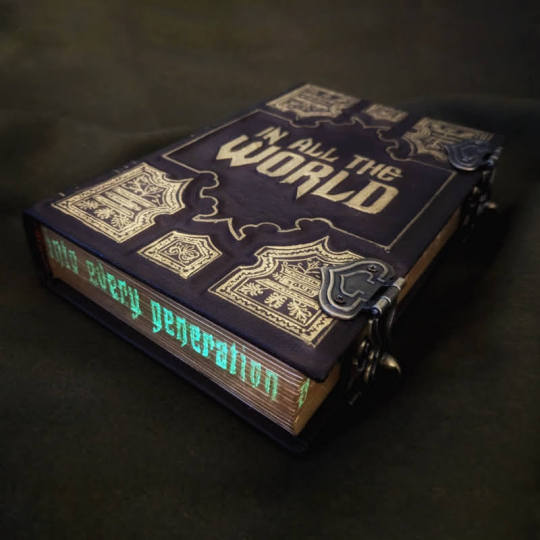

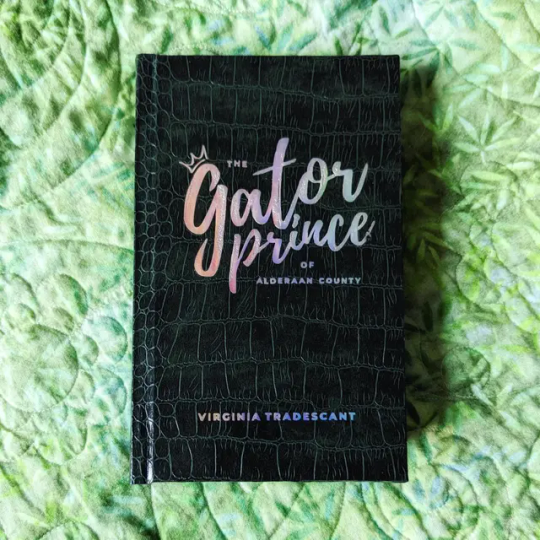


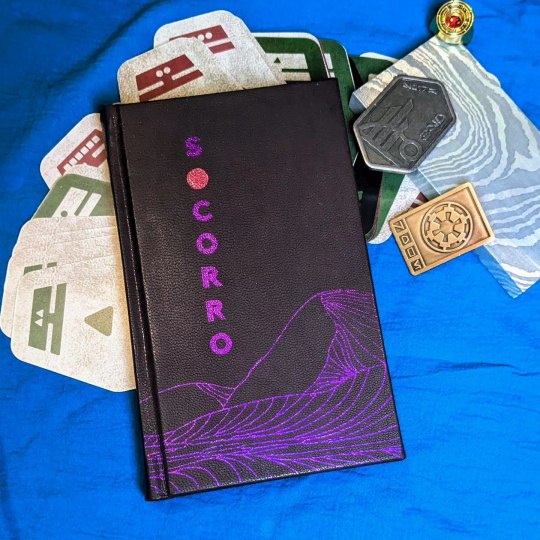
Starblight Bindery is a fan fiction bookbinder based in Southern California who creates one-of-a-kind, handmade bespoke books.
One of my goals is to make fanfic binding more accessible, so in addition to the books I make, I'll also be posting tutorials, tips, and resources. How to make a nipping press from plumbing pipe, tutorials on applying foil to bookcloth, and more. I've also started a small online store where I sell FanFic Bookbinding Starter Packs for folks interested in breaking into the hobby.
I'm hoping this tumblr will give me space to go more in-depth on my process than Instagram. Cheers!
14 notes
·
View notes